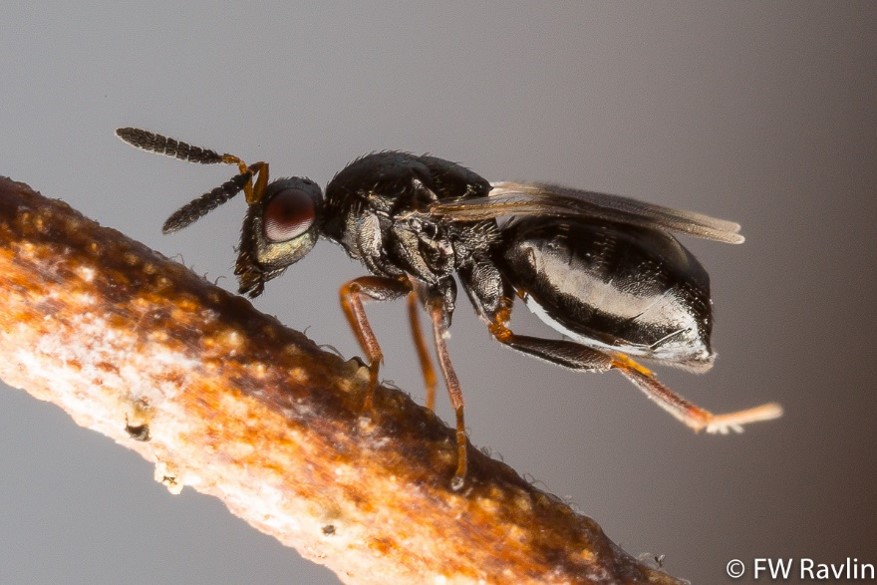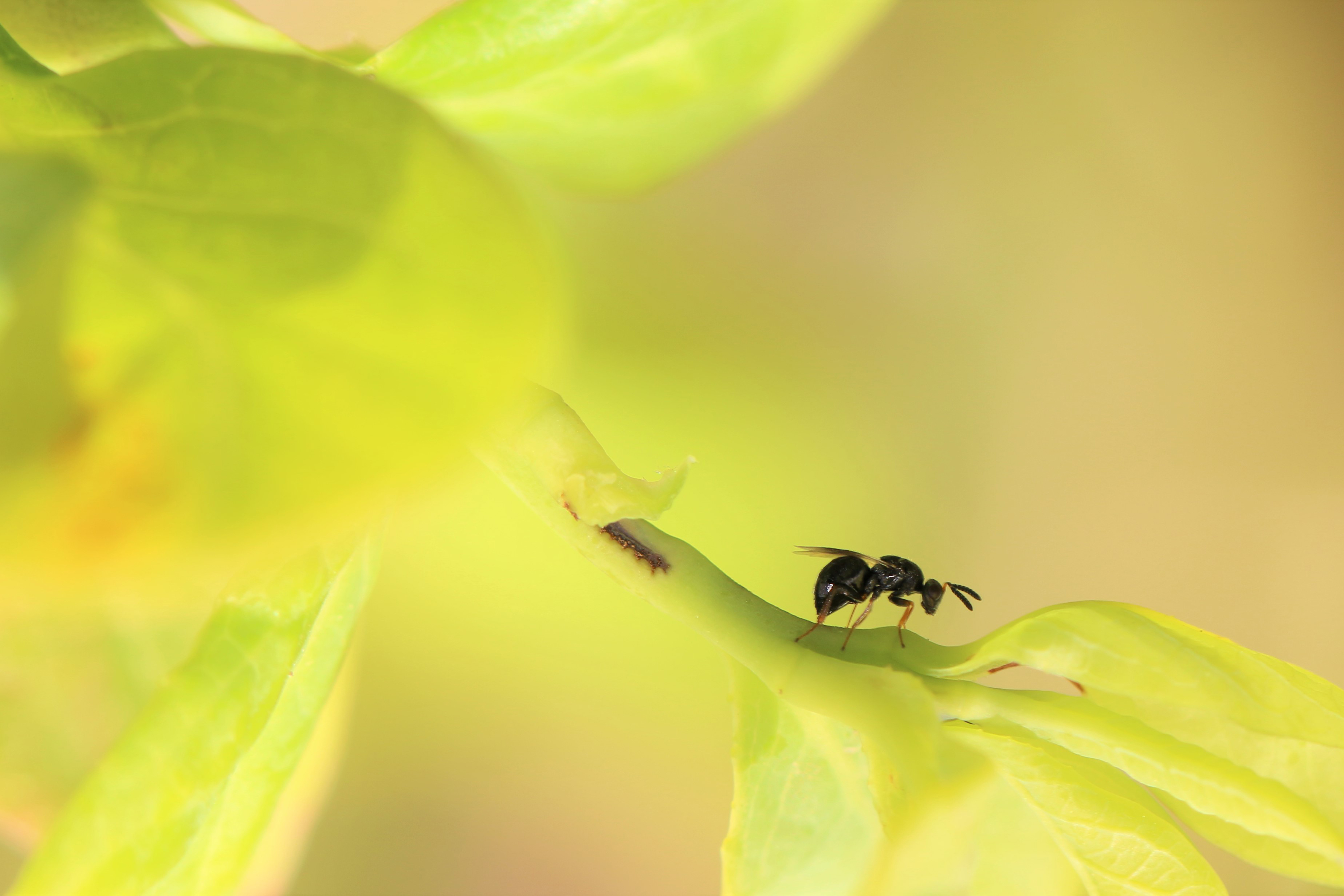
Michigan State University (MSU) entomology and fruit breeding programs are teaming up to contain, control and combat blueberry stem gall wasp, an insect whose damage can lead to reduced yield — and profit — for Michigan blueberry growers.
Rufus Isaacs, professor in the Department of Entomology, and Patrick Edger, assistant professor in the Department of Horticulture, are collaborating on research to slow the spread of and ultimately build resistance to the blueberry stem gall wasp. The project is funded by the U.S. Department of Agriculture, MSU Rackham Foundation Research Endowment, Michigan Department of Agriculture and Rural Development, and Michigan Blueberry Commission.
“The outcomes of this collaborative research will address a top industry concern of blueberry growers in Michigan,” Edger said. “Preventing pest damage is critical for successful fruit production, and this project combines MSU expertise from different disciplines to tackle this challenge.”
The blueberry stem gall wasp is a tiny insect that lays eggs inside blueberry shoots. Some varieties respond by swelling and making a gall, a mass of new tissue. Larvae develop inside the gall, which stays on the shoot and decreases fruit production. Isaacs estimates the insect has affected about 10% of Michigan’s blueberry crop acreage.
Edger and Isaacs’ partnership dates back to a seminar that Edger gave in 2015 before accepting his current position at MSU, shortly after the blueberry stem gall wasp became a priority area of focus for Michigan blueberry growers.
“We were already developing this problem with the industry here in Michigan before Dr. Edger was hired,” Isaacs said. “As soon as he was here, we started talking about the blueberry stem gall wasp and how we can work together to solve the issues it causes.”
Patrick Edger: breeding resistant cultivars
Edger focuses on breeding new cultivars that are resistant to the blueberry stem gall wasp.
“Michigan growers are the utmost priority for the MSU Blueberry Breeding Program,” Edger said. “The goal is to have all future cultivar releases be resistant to this insect and also have improvements in many other traits that are important to our growers.”
To breed blueberries that are resistant to diseases and pests, Edger looks at the fruit’s genome to make decisions on which plants to include or exclude in the breeding program. This is different from a GMO approach, which involves augmenting the genome by directly placing a gene with the desired trait into the crop.
“The technology we helped develop is equivalent to what 23andMe uses,” Edger said. “We can take a look at the genome of an individual blueberry plant and see if it has the correct version of the gene that will make it resistant to a particular disease or pest while also screening genes important for many other target traits. What that allows us to do is accelerate the breeding process. Instead of putting a plant in the field and waiting three to four years, we can tell from day one whether an offspring, typically a young seedling, from a genetic cross will actually exhibit those favorable traits.”
Phillip Fanning, a postdoctoral researcher in Isaacs’ lab, provides Edger with blueberry stem gall wasps to test the resistance of the cultivars he breeds.

“Dr. Edger is developing the plants, getting them to the point where they’re ready to test,” Isaacs said. “Dr. Fanning has delivered large numbers of wasps to expose those plants to and test whether they are resistant or not. Through this collaboration, Dr. Edger is working out which plants are resistant and what genetics the resistant plants contain.”
Among Michigan blueberry varieties, Duke (which accounted for 4% of the total acreage of blueberries grown in the state in 2018), Elliott (19%) and Bluecrop (26%) are most resistant to the blueberry stem gall wasp. Liberty (3%) and Jersey (27%) are some of the least resistant.
Rufus Isaacs: slowing the spread
While Edger’s work involves investigating why some varieties are more susceptible than others, Isaacs’ research focuses on mitigating the pest.
“We’re conducting research to provide short-term solutions, and Dr. Edger is developing the long-term solutions,” Isaacs said.
Managing the blueberry stem gall wasp comes with many challenges.
Blueberry stem gall wasp is native to the eastern United States and Canada. Because it is a native species, it has many natural enemies, which should help reduce its population. Those natural enemies, however — other wasps and parasites that inhabit its galls — have been affected by grower efforts to manage another pest: a tiny invasive vinegar fly called spotted wing drosophila.
“Management for spotted wing drosophila seems to have reduced some of the blueberry stem gall wasp’s natural enemies in blueberry fields,” Isaacs said. “The natural enemies were probably regulating it, but now they have been disrupted by the pest management programs for spotted wing drosophila.”
In addition, the insecticides available for use in blueberry have changed. Isaacs and Fanning hypothesize that this is also linked to the rise of the blueberry stem gall wasp.
“We saw the loss of some effective insecticides at the same time as the blueberry stem gall wasp’s natural enemies were being knocked out,” Isaacs said. “It’s a disrupted system, showing an unintended consequence of having more restrictions and an invasive pest at the same time."

Because wasps are closely related to bees, there is another hurdle.
“One of the issues with this pest is that it’s active when bees are visiting the crop flowers. Growers are very focused on protecting bees during the crop bloom because they need pollination to get good yields,” Isaacs said. “This restricts options for control when the wasp is flying around and active.”
Solutions: short- and long-term
Growers currently manage blueberry stem gall wasp through a combined approach. In addition to pruning and protecting their susceptible fields from gall wasp, each year they’ll pull out some area of susceptible varieties and replace them with a resistant cultivar. This gradual approach preserves production and profits, which would likely drop if those susceptible varieties were removed all at once.
“My research team is trying to reduce the pest’s impact in existing plantings, but that requires pruning and insecticide applications applied after honeybees are removed from the fields,” Issacs said.
If growers remove fields of the current susceptible cultivars, MSU can now provide guidance on resistant cultivars to plant in their place. That list is likely to grow as the MSU breeding program develops new varieties.
“In the long run, resistant cultivars will be the solution,” Isaacs said.
Fanning agreed.
“Resistant cultivars will result in a blueberry crop that’s higher yielding and better for the industry, with greater sustainability,” he said.



 Print
Print Email
Email




